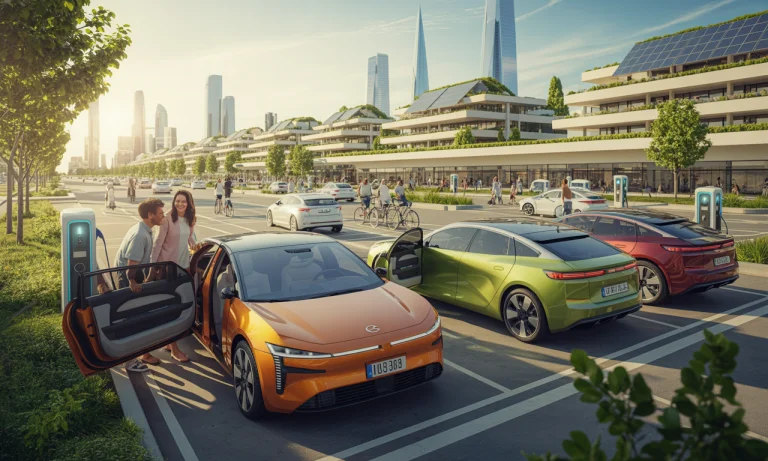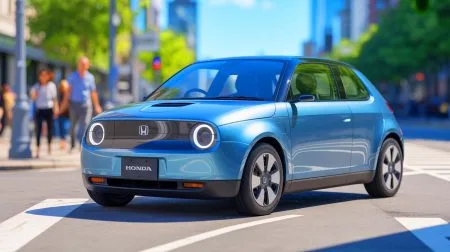As cities transform and climate anxieties become daily realities, the conversation around electric vehicles (EVs) has shifted from hype to tangible change. The streets that once echoed with the growl of combustion engines now hum quietly as Teslas, Rivians, and Hyundai IONIQs zip past, reflecting a future that’s no longer on the horizon—it’s parked at the curb. Beneath the surface-level debates about range and sticker price lies a world of benefits that early adopters and curious newcomers alike are only beginning to realize. From the tech-savvy commuter using apps like ZEVA to monitor every watt, to the family leveraging tax incentives while skipping gas lines in their Chevrolet Bolt, the hidden perks are quietly reshaping lifestyles, economies, and entire communities. This in-depth narrative uncovers how the simple act of choosing an EV in 2025 is more than just a nod to sustainability—it’s a gateway to unexpected comfort, financial resilience, and an exhilarating new relationship with the road.
How Electric Cars Drive a Positive Environmental Shift in 2025
Not so long ago, clear morning air in urban centers seemed like a utopian dream. In 2025, a stroll with Maya—a lifelong Parisian who made the switch to a Volkswagen ID.4—reveals a landscape less dominated by exhaust and noise. The embrace of EVs like those from Nissan, BMW, and Polestar is sculpting healthier neighborhoods by slashing tailpipe emissions to zero. For Maya, swapping her old gas-powered Renault for an electric ride stemmed from watching local air quality decline, pushing her to search for alternatives that protected both her family and the community.
It’s not just about cleaner air: every mile driven by electric vehicles means less dependence on fragile oil markets. The story of one Lucid Motors sedan, charging at home while the city sleeps, is echoed in data from urban study groups—airborne particles drop, carbon footprints shrink. Governments, recognizing these cascading benefits, continue rolling out incentives that tie directly to lower emissions, nudging more drivers away from fossil fuels. For a deeper look into how electric cars outpace their gas rivals, including detailed carbon calculations, check this comparison.
| Brand | Key Environmental Benefit | Model Example |
|---|---|---|
| Tesla | Zero tailpipe emissions | Model 3 |
| Volkswagen | Lower carbon footprint | ID.4 |
| Nissan | Reduced urban air pollution | Leaf |
| BMW | Integration with renewables | i4 |
Stories from Areas Embracing Electric Mobility
Consider city policies that once heavily restricted traffic. Thanks to EV-friendly regulations, the landscape is changing: families enter downtown zones with ease, skipping costly permits. Curious about how infrastructure growth is influencing EV adoption? Find more insights here.
The Financial Edge: Cost Savings and Budget Freedom
Leo, an accountant who once swore by his Ford pickup for daily commutes, found himself recalculating family budgets as gas prices inched higher each year. After making the leap to a Ford F-150 Lightning, Leo noted the small but steady changes to his spending. The line items for fuel shrank to nearly nothing, swapped for affordable off-peak charging at home. He tallied the savings, factoring in those surprise-free maintenance invoices—no more oil changes, transmission repairs, or exhaust system fixes.
The advantage grows with long-term incentives. Whether via tax rebates, purchase credits, or discounted insurance, governments and automakers such as Chevrolet and Hyundai are sweetening the deal. For new buyers considering the sticker price, tools that compare ownership costs reveal the true financial picture. Want concrete breakdowns matching your region and driving habits? This cost analysis sheds light on where those savings add up the most.
| Expense Category | Gas Car (per year) | Electric Car (per year) |
|---|---|---|
| Fuel/Charging | $1,800 | $480 |
| Maintenance | $1,000 | $350 |
| Tax credits/incentives | None | Up to $7,500* |
*Varying local/state policy in 2025
Real Experiences with Financial Benefits
Owners like Leo notice other unexpected perks: the resale value of their cars remains high, thanks to stable battery tech and growing demand. Still weighing the economic case for an EV? Explore car-buying mistakes and smart choices in this guide for 2025 shoppers.
Technology that Transforms the Drive: Hidden Features of Modern EVs
For Amira and her Polestar 2, an ordinary commute takes a turn for the extraordinary with each push of the accelerator. Instant torque means traffic lights feel less like a delay and more like a launchpad. As she navigates city routes, the vehicle’s regenerative braking smoothly recycles energy, while smart connectivity allows her to check battery status or pre-heat the cabin—all from a smartphone. Behind the scenes, robust battery management and software updates from the likes of Tesla and Lucid Motors keep every ride not just current, but ahead of the curve.
These advancements don’t only benefit the tech-obsessed. Parents tracking their kids’ first solo drives, professionals maximizing efficiency, and even neighbors sharing cars thanks to new subscription platforms—all tap into the power of innovation. The line between car and companion is blurring, as apps like ZEVA deliver deep insights into driving habits, battery health, and optimal charging times. Discover what advancements are now standard in modern EVs by checking out the latest tech overview.
| Technological Feature | EV Brands | Everyday Benefit |
|---|---|---|
| Regenerative Braking | Hyundai, Nissan, Tesla | Energy efficiency, reduced brake wear |
| Advanced Connectivity | Lucid Motors, Polestar, BMW | Remote monitoring/control |
| Autonomous Features | Tesla, Rivian, Ford | Driver assistance, safer travel |
EV Technology in Everyday Life
Tech doesn’t stop at comfort—it’s changing the playing field for car safety and lifecycle. Curious about how self-driving capabilities are shaping the future? Dive into autonomous possibilities here.
Charging Infrastructure: Convenience that Silences the Skeptics
Any road trip featured in family photo albums from 2021 carried the subplot of “where’s the next gas station?” For 2025, that anxiety takes a back seat. Eve, a Chevy Bolt driver, finds public charging points woven into urban landscapes and rest stops along highways. Fast-charging tech trims wait times, and for daily commutes, at-home charging means her car is always ready by morning. Municipalities partner with renewable energy projects, ensuring her electricity is cleaner year after year.
Still, the joys of modern infrastructure are unevenly distributed. Some rural towns lag behind, meaning longer distances might require strategic planning and apps to map every charging stop. Eve’s experience, and those of many others who balance city commutes with the occasional cross-country trek, highlight the continued evolution—and optimism—for even broader accessibility. For detailed side-by-side assessments of charging speed and options, explore this charging comparison resource.
| Charging Type | Typical Charge Time | Where Found |
|---|---|---|
| Level 1 (110V) | 8-12 hours | Home, workplace |
| Level 2 (240V) | 4-6 hours | Home, public parking |
| DC Fast Charging | 30-60 min | Highways, urban hubs |
Personal Stories: From Range Anxiety to Charging Confidence
Long trips now unfold with new rituals: coffee breaks during fast charging, digital maps suggesting scenic stops. For those curious about maximizing range on these trips, find reliable data in this up-to-date long-range guide.
Overcoming Hurdles: What New EV Owners Should Watch For
However, every innovation brings new questions. Battery life, upfront price tags, and infrastructure gaps still linger in buyer conversations. Take Jessica, who fell in love with a BMW i4 but was concerned about long-term battery health. She uncovered practical tips for prolonging performance, like using smart charging routines available in most new EVs—often extending battery longevity well past initial projections.
Potential EV buyers are encouraged to compare purchase incentives, test-drive a range of brands, and calculate true long-term value—including resale forecasts and maintenance costs. Experts caution against fixating on the initial surge of tech novelty; instead, a steady focus on matching one’s driving habits with the right EV features pays off best. For a full checklist before buying, this 2025 new car advice is invaluable.
Insights for Smart EV Decisions
As the market evolves, stories multiply: families celebrating surprise-free repair bills, first-time buyers finding unexpected joy in silent red-light moments, or carpool parents taking advantage of new EV sharing clubs. If you’re considering joining their ranks, real-world test drives and community feedback matter. Arrange your own experience and get tips from veterans via this test-drive walkthrough.
Frequently Asked Questions About Hidden EV Benefits in 2025
How much can I really save on maintenance with an electric car?
Maintenance costs for EVs are often 50-70% lower than for gas vehicles, as there are no oil changes, fewer moving parts, and most repairs are software-based or simple replacements. Interested in long-term savings? Find details here.
Will my EV’s resale value hold up?
Thanks to evolving battery tech and high demand, electric cars from brands like Tesla, Ford, and Volkswagen are retaining value more robustly, especially if well-maintained. For tips on boosting your car’s future value, explore this guide.
What’s the biggest challenge for new EV owners in 2025?
While charging access has expanded, time to recharge—especially on long trips—remains a challenge. Planning routes with public fast chargers or leveraging workplace solutions helps ease the transition. For up-to-date advice, check the latest infrastructure updates.
How do I know which EV brand suits my needs?
Your ideal match depends on range, budget, and tech features. Brands like Tesla and Lucid Motors lead in technology, while Nissan and Chevrolet offer practical affordability. Compare the best options for diverse lifestyles in this detailed article here.
Are there benefits to home charging versus public stations?
Home charging offers maximized convenience and lower costs by letting you charge overnight at off-peak rates. Public fast chargers are best for travel or heavy use. For a side-by-side breakdown, explore this evaluation.
Did you like it? 4.5/5 (27)







